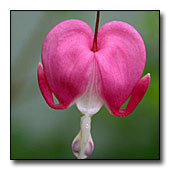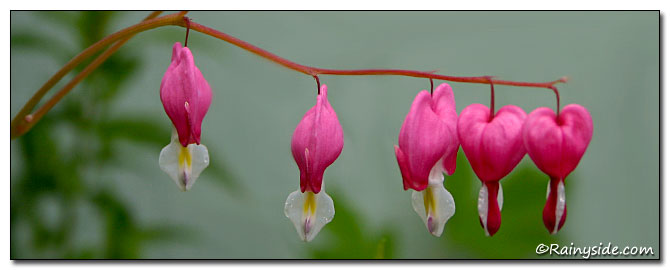Lamprocapnos spectabilis
OLD FASHIONED BLEEDING HEART, ASIAN BLEEDING-HEART, LADY IN A BATH, LYRE FLOWER, DUTCHMAN'S TROUSERS, VENUS'S CAR
syn. Dicentra spectabilis
Family: Papaveraceae
Pronounced: lam-pro-CAP-nus spek-TAH-bi-lis

Quick Jumps
Growing Guide
Rainy Side Notes
GROWING GUIDE

Origin:
Siberia, North China, Korea.
Plant Group:
Perennial.
Hardiness:
Sunset zones: A1-A3; 1-9, 14-24.
USDA zones: 3-9.
Mature size:
Height: 4 feet (1.2 m).
Width: 18 inches (45 cm).
Flowering period:
Late spring to early summer.
Flowering attributes:
Pink, heart-shaped petals on the outside with white petals on the inside. Three to fifteen flowers hang on racemes on arching horizontal stems.
Leaf attributes:
Coarsely divided, soft green foliage.
Growth habit:
Clump-forming.
Light:
Partial shade; full sun if extra moisture is provided, but better if shaded from hot midday sun.
Soil:
Moist, fertile, humus rich, well-drained soil.
Feeding:
Side dress with compost or manure. Fertilize in spring with a complete organic fertilizer.
Propagation Methods:
Sow in containers and keep at temperatures of 64-71ºF (18-22ºC) for 2-4 weeks. Then move to reduced temperatures of 24-39ºF (-4 to +4ºC) for 4-6 weeks. Then move to temperatures of 41-53ºF5 (-12ºC) until the seeds germinate.
Root cuttings, 3-4 inches long in March.
Divide dormant rhizome after flowering.
Pests and Diseases:
Slugs and snails may be a problem with young plants.
Rainy Side Notes

Sometime ago, while I was sleeping, the species spectabilis and its cultivars of the genus Dicentra was changed to Lamprocapnos (its original name was published in an article in 1850). I’ve seen the name before, but didn’t make the connection, until I was researching for a piece I was writing on one of its cultivars, L. ‘Valentine’. The genus name was changed in 1993, but it wasn’t until 2006 before the Royal Horticulture Society published the change. It’s going to take me some time to get used to the new name for one of my old favorites. It appears the gardening community is also slow on accepting the change back to its preexisting name, and still sold as a Dicentra.
There was literature from the 1800s that talked about the plants in Europe, but the plants were not widely cultivated and soon forgotten. In 1846, Scottish plant hunter Robert Fortune reintroduced it from Japan to England. Many years before the Western world came to know it, the Chinese and Japanese cultivated the species.
Most commonly called bleeding heart, Lamprocapnos has a copious amount of common names such as Asian bleeding heart, old-fashioned bleeding heart, lady in a bath, lyre flower, Dutchman's trousers, and Venus's car—yes, seriously—Venus’s car. The common name lyre flower most likely came because it resembles a lyre—a medieval bowed instrument of the violin family.
The name Lamprocapnos arises from the Greek words lampros, which means shining or bright, and kapnos, which means smoke. Put together it becomes bright smoke. Its epithet, spectabilis means spectacular. I want to pronounce it in the same fashion as Billy Crystal pronounces marvelous. I can hear him now. "You look MAH-va-lous dahling! You look spek-TAB-ih-lis, dahling!"
Beautiful in the shade garden, this popular perennial has foliage that mixes well with ferns and other shade tolerant plants. The striking, well-defined, rose-red hearts are a good reason to grow this one. Because they go dormant by midsummer, I grow it tucked in amongst ferns and other plants, where the missing foliage is not too noticeable. When the plant goes dormant in summer, some people mistake the dying foliage to be from a disease.
Lamprocapnos spectabilis grows best in partial shade but here in the maritime Northwest we can grow them in full sun if we provide extra moisture. However, they are better when protected from hot midday sun.
The Royal Horticultural Society gave this species an Award of Garden Merit.
More Lamprocapnos
More Dicentras
Photographed in author's garden.
A Pacific Northwest Plant of the Week (2012)

Gardening for the Homebrewer: Grow and Process Plants for Making Beer, Wine, Gruit, Cider, Perry, and More
By co-authors Debbie Teashon (Rainy Side Gardeners) and Wendy Tweton
Copyright Notice | Home | Search | Perennials

